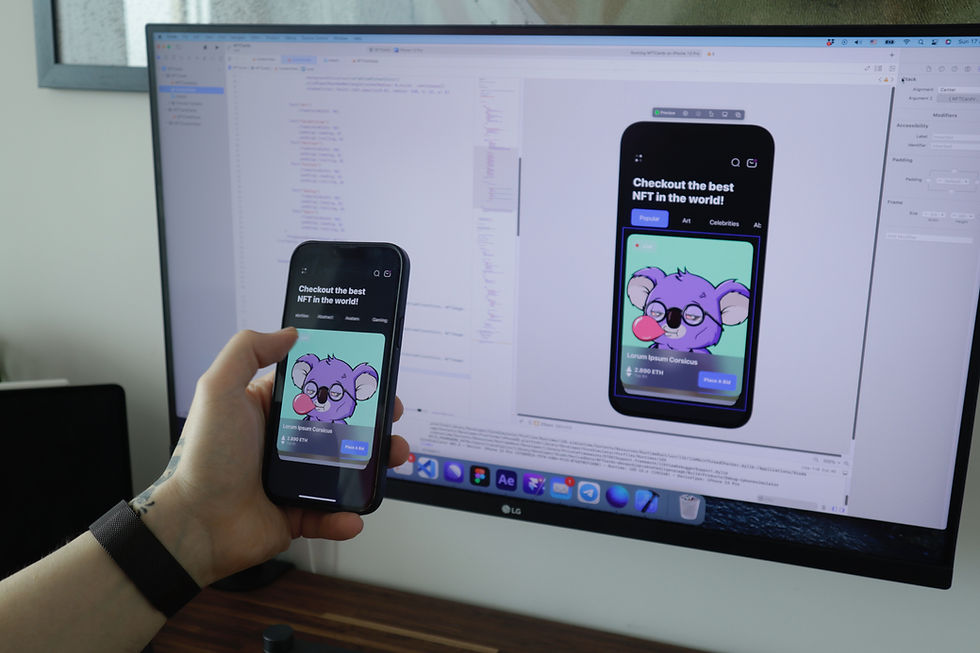Introduction to Native Development Kit (NDK) for High-Performance Android Development
- Don Peter

- May 1, 2023
- 5 min read

If you're an Android developer, you may be familiar with the Native Development Kit (NDK) – a toolset that allows developers to write native code in C/C++ for Android applications. Although the NDK is not necessary for all apps, it can be extremely useful in certain situations, such as when working with performance-critical code or with third-party libraries written in C/C++.
In this blog post, we'll explore how to use the NDK for Android development, and discuss some best practices for using it effectively.
Reasons to use the NDK for Android development
To start with, let's consider why one would want to use the NDK. One of the most common reasons is performance. Java/Kotlin, the primary languages used for Android development, runs on a virtual machine (VM) and requires some overhead to execute. By contrast, native code can be optimized for the specific hardware it runs on, leading to improved performance. This can be particularly important for apps that require real-time processing, such as games or audio/video applications.
Another reason to use the NDK is to work with existing code libraries written in C or C++. Rather than having to rewrite these libraries in Java/Kotlin, you can use the NDK to call them directly from your Android app. This can save time and effort, as well as make it easier to maintain compatibility with existing code.
Installing and setting up the NDK in Android Studio
So how does one use the NDK for Android development? The first step is to download and install the NDK from the Android Studio SDK Manager.
Once you have the NDK installed, you can create a new module in your Android Studio project specifically for native code. This will allow you to write and compile C/C++ code that can be called from your Java/Kotlin code.
Using the Java Native Interface (JNI) to call native code from Java
To call native code from Java/Kotiln, you'll need to use the Java Native Interface (JNI). This is a programming framework that allows Java/Kotlin code to interact with native code. Essentially, you'll write a Java/Kotlin method that calls a native method, passing arguments back and forth between the two. The native method can then perform some action – for example, processing audio data – and return a result to the Java/Kotlin code.
Native function (written in C/C++ and compiled with the NDK):
#include <jni.h>
JNIEXPORT jstring JNICALL Java_com_example_myapp_MainActivity_nativeFunction(JNIEnv *env, jobject obj) {
return (*env)->NewStringUTF(env, "Hello from native code!");
}
Kotlin Code:
class MainActivity : AppCompatActivity() {
companion object {
init {
System.loadLibrary("native-lib")
}
}
external fun nativeFunction(): String
override fun onCreate(savedInstanceState: Bundle?) {
super.onCreate(savedInstanceState)
setContentView(R.layout.activity_main)
// Call native function and display result
val result = nativeFunction()
val textView = findViewById<TextView>(R.id.text_view)
textView.text = result
}
}
In this example, the native function is named Java_com_example_myapp_MainActivity_nativeFunction and takes no arguments. It returns a jstring object that is constructed using the NewStringUTF function, which is part of the JNI API.
The function name "Java_com_example_myapp_MainActivity_nativeFunction" is actually a convention for naming JNI functions that are called from Java code.
In this naming convention, "Java_" is a prefix that indicates that the function is called from Java code, followed by the fully qualified name of the Java class that contains the native function (in this case, "com_example_myapp_MainActivity"). Finally, the name of the native function is appended to the end of the function name (in this case, "nativeFunction").
So when you call nativeFunction() in your Java code, the JNI runtime looks for a native function with the name "Java_com_example_myapp_MainActivity_nativeFunction" and invokes it. This naming convention is important because it allows the JNI runtime to find the correct native function to call based on the name of the Java class and the name of the native function.
In the Kotlin code, we declare a native method nativeFunction using the native keyword. We also load the native library using the System.loadLibrary method. Finally, we call the nativeFunction method and display the result in a TextView.
Best practices for writing native code, including memory management and platform compatibility
When writing native code, there are a few things to keep in mind. First and foremost, you'll need to be careful about memory management. Native code does not have the same garbage collection as Java/Kotlin, so you'll need to manually allocate and free memory as needed. This can be challenging, particularly if you're not used to working with lower-level programming languages like C or C++.
Here are some of the best practices for writing native code in C/C++ that is compatible with Android platforms and includes proper memory management:
Use the Android NDK:
The Android Native Development Kit (NDK) provides a set of tools and APIs for developing native code that runs on Android devices. By using the NDK, you can access platform-specific features and optimize your code for performance.
Avoid memory leaks:
Memory leaks occur when you allocate memory but don't release it when it's no longer needed. To avoid memory leaks, use the malloc() and free() functions to allocate and release memory dynamically. Be sure to release all memory before your function returns.
// Allocate memory
char* buffer = (char*) malloc(100);
// Do something with buffer
// Release memory
free(buffer);
Use smart pointers:
Smart pointers are objects that automatically manage the memory of other objects. By using smart pointers, you can avoid memory leaks and reduce the risk of memory corruption.
// Declare a smart pointer
std::unique_ptr<char[]> buffer(new char[100]);
// Do something with buffer
buffer[0] = 'H';
buffer[1] = 'i';
// Memory is released automatically when buffer goes out of scope
Avoid global variables:
Global variables can cause memory leaks and other problems. Instead, pass variables as function arguments or use local variables.
// Bad practice: using a global variable
int count = 0;
void increment() {
count++;
}
// Good practice: using a local variable
void increment(int& count) {
count++;
}
Use platform-independent code:
Another consideration is platform compatibility. Because native code is compiled specifically for a particular hardware platform, you'll need to make sure that your code is compatible with all of the platforms that you want to support. This can be particularly challenging if you're working with older or less common hardware. To ensure that your code works on all platforms, use platform-independent code as much as possible. Avoid using platform-specific headers and functions, and use standard C/C++ libraries instead.
// Bad practice: using a platform-specific header
#include <android/log.h>
// Good practice: using a standard C/C++ header
#include <stdio.h>
By following these best practices, you can write native code that is compatible with Android platforms and includes proper memory management.
Testing and profiling native code with tools like the Android NDK Profiler
Finally, it's important to test your native code thoroughly to ensure that it's performing as expected. This can be done using tools like the Android NDK Profiler, which allows you to monitor the performance of your native code in real-time.
Conclusion
NDK can be a powerful tool for Android developers, particularly when it comes to performance-critical code or working with existing C/C++ libraries. However, using the NDK effectively requires careful attention to memory management, platform compatibility, and testing. If you're considering using the NDK for your Android app, be sure to carefully weigh the benefits and challenges, and consult resources like the Android NDK documentation and online developer communities for best practices and support.



Comments